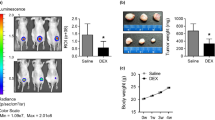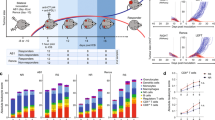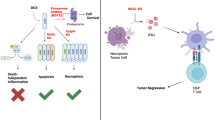Abstract
Interleukin-1β (IL-1β) is a cytokine that shares with tumor necrosis factor (TNF) the ability to initiate largely similar signaling pathways, leading to proinflammatory gene expression. In contrast to TNF, however, IL-1β is not believed to induce tumor cell death. Here we demonstrate that prolonged treatment with IL-1β, in combination with interferon-γ (IFNγ), is cytotoxic for L929 tumor cells. IL-1β/IFNγ-induced cytotoxicity requires only minimal amounts of IL-1β and shows morphological features of necrosis. Although TNF induces a similar response, we could exclude a contribution of endogenous TNF production in the effect of IL-1β/IFNγ. Cell death in response to IL-1β/IFNγ is independent of caspases, but requires the IL-1β/IFNγ-induced production of inducible nitric oxide synthase (iNOS) and NO. Moreover, necrosis and iNOS/NO production could be prevented by treatment of the cells with a p38 mitogen activated protein kinase (p38MAPK) or IκB kinase β inhibitor. Altogether, these findings demonstrate that prolonged exposure to IL-1β plus IFNγ induces L929 tumor cell necrosis, via a p38MAPK and nuclear factor-κB (NF-κB)-dependent signaling pathway, leading to the expression of iNOS and the production of toxic NO levels.
This is a preview of subscription content, access via your institution
Access options
Subscribe to this journal
Receive 50 print issues and online access
$259.00 per year
only $5.18 per issue
Buy this article
- Purchase on SpringerLink
- Instant access to full article PDF
Prices may be subject to local taxes which are calculated during checkout





Similar content being viewed by others
References
Beyaert R, Cuenda A, Vanden Berghe W, Plaisance S, Lee JC, Haegeman G et al. (1996). The p38/RK mitogen-activated protein kinase pathway regulates interleukin-6 synthesis response to tumor necrosis factor. EMBO J 15: 1914–1923.
Beyaert R, Heyninck K, De Valck D, Boeykens F, van Roy F, Fiers W . (1993). Enhancement of tumor necrosis factor cytotoxicity by lithium chloride is associated with increased inositol phosphate accumulation. J Immunol 151: 291–300.
Beyaert R, Van Loo G, Heyninck K, Vandenabeele P . (2002). Signaling to gene activation and cell death by tumor necrosis factor receptors and Fas. Int Rev Cytol 214: 225–272.
Brune B, von Knethen A, Sandau KB . (1998). Nitric oxide and its role in apoptosis. Eur J Pharmacol 351: 261–272.
Cnop M, Welsh N, Jonas JC, Jorns A, Lenzen S, Eizirik DL . (2005). Mechanisms of pancreatic beta-cell death in type 1 and type 2 diabetes: many differences, few similarities. Diabetes 54 (Suppl 2): S97–S107.
Cuenda A, Rouse J, Doza YN, Meier R, Cohen P, Gallagher TF et al. (1995). SB 203580 is a specific inhibitor of a MAP kinase homologue which is stimulated by cellular stresses and interleukin-1. FEBS Lett 364: 229–233.
Davies SP, Reddy H, Caivano M, Cohen P . (2000). Specificity and mechanism of action of some commonly used protein kinase inhibitors. Biochem J 351: 95–105.
Degterev A, Huang Z, Boyce M, Li Y, Jagtap P, Mizushima N et al. (2005). Chemical inhibitor of nonapoptotic cell death with therapeutic potential for ischemic brain injury. Nat Chem Biol 1: 112–119.
Dunne A, O'Neill LA . (2003). The interleukin-1 receptor/Toll-like receptor superfamily: signal transduction during inflammation and host defense. Sci STKE 2003: re3.
Earnshaw WC, Martins LM, Kaufmann SH . (1999). Mammalian caspases: structure, activation, substrates, and functions during apoptosis. Annu Rev Biochem 68: 383–424.
Eizirik DL, Mandrup-Poulsen T . (2001). A choice of death—the signal-transduction of immune-mediated beta-cell apoptosis. Diabetologia 44: 2115–2133.
Festjens N, Vanden Berghe T, Vandenabeele P . (2006). Necrosis, a well-orchestrated form of cell demise: signalling cascades, important mediators and concomitant immune response. Biochim Biophys Acta 1757: 1371–1387.
Fransen L, Van der Heyden J, Ruysschaert R, Fiers W . (1986). Recombinant tumor necrosis factor: its effect and its synergism with interferon-gamma on a variety of normal and transformed human cell lines. Eur J Cancer Clin Oncol 22: 419–426.
Garcia-Calvo M, Peterson EP, Leiting B, Ruel R, Nicholson DW, Thornberry NA . (1998). Inhibition of human caspases by peptide-based and macromolecular inhibitors. J Biol Chem 273: 32608–32613.
Golstein P, Kroemer G . (2007). Cell death by necrosis: towards a molecular definition. Trends Biochem Sci 32: 37–43.
Green LC, Wagner DA, Glogowski J, Skipper PL, Wishnok JS, Tannenbaum SR . (1982). Analysis of nitrate, nitrite, and [15N]nitrate in biological fluids. Anal Biochem 126: 131–138.
Heitmeier MR, Scarim AL, Corbett JA . (1997). Interferon-gamma increases the sensitivity of islets of Langerhans for inducible nitric-oxide synthase expression induced by interleukin 1. J Biol Chem 272: 13697–13704.
Huang H, Rose JL, Hoyt DG . (2004). p38 Mitogen-activated protein kinase mediates synergistic induction of inducible nitric-oxide synthase by lipopolysaccharide and interferon-gamma through signal transducer and activator of transcription 1 Ser727 phosphorylation in murine aortic endothelial cells. Mol Pharmacol 66: 302–311.
Itoh S, Hattori T, Hayashi H, Mizutani Y, Todo M, Takii T et al. (1999). Antiproliferative effect of IL-1 is mediated by p38 mitogen-activated protein kinase in human melanoma cell A375. J Immunol 162: 7434–7440.
Janik JE, Miller LL, Longo DL, Powers GC, Urba WJ, Kopp WC et al. (1996). Phase II trial of interleukin 1 alpha and indomethacin in treatment of metastatic melanoma. J Natl Cancer Inst 88: 44–49.
Janssens S, Beyaert R . (2003). Functional diversity and regulation of different interleukin-1 receptor-associated kinase (IRAK) family members. Mol Cell 11: 293–302.
Kim HJ, Hawke N, Baldwin AS . (2006a). NF-kappaB and IKK as therapeutic targets in cancer. Cell Death Differ 13: 738–747.
Kim YJ, Hwang SY, Oh ES, Oh S, Han IO . (2006b). IL-1beta, an immediate early protein secreted by activated microglia, induces iNOS/NO in C6 astrocytoma cells through p38 MAPK and NF-kappaB pathways. J Neurosci Res 84: 1037–1046.
Kim YS, Morgan MJ, Choksi S, Liu ZG . (2007). TNF-induced activation of the Nox1 NADPH oxidase and its role in the induction of necrotic cell death. Mol Cell 26: 675–687.
Kishore N, Sommers C, Mathialagan S, Guzova J, Yao M, Hauser S et al. (2003). A selective IKK-2 inhibitor blocks NF-kappa B-dependent gene expression in interleukin-1 beta-stimulated synovial fibroblasts. J Biol Chem 278: 32861–32871.
Kleinert H, Pautz A, Linker K, Schwarz PM . (2004). Regulation of the expression of inducible nitric oxide synthase. Eur J Pharmacol 500: 255–266.
Kleinert H, Schwarz PM, Forstermann U . (2003). Regulation of the expression of inducible nitric oxide synthase. Biol Chem 384: 1343–1364.
Kobayashi T, Walsh MC, Choi Y . (2004). The role of TRAF6 in signal transduction and the immune response. Microbes Infect 6: 1333–1338.
Larsen CM, Wadt KA, Juhl LF, Andersen HU, Karlsen AE, Su MS et al. (1998). Interleukin-1beta-induced rat pancreatic islet nitric oxide synthesis requires both the p38 and extracellular signal-regulated kinase 1/2 mitogen-activated protein kinases. J Biol Chem 273: 15294–15300.
Lejeune FJ, Lienard D, Matter M, Ruegg C . (2006). Efficiency of recombinant human TNF in human cancer therapy. Cancer Immun 6: 6.
Lejeune FJ, Ruegg C . (2006). Recombinant human tumor necrosis factor: an efficient agent for cancer treatment. Bull Cancer 93: E90–E100.
Liu D, Pavlovic D, Chen MC, Flodstrom M, Sandler S, Eizirik DL . (2000). Cytokines induce apoptosis in beta-cells isolated from mice lacking the inducible isoform of nitric oxide synthase (iNOS−/−). Diabetes 49: 1116–1122.
Madrid LV, Mayo MW, Reuther JY, Baldwin Jr AS . (2001). Akt stimulates the transactivation potential of the RelA/p65 Subunit of NF-kappa B through utilization of the Ikappa B kinase and activation of the mitogen-activated protein kinase p38. J Biol Chem 276: 18934–18940.
Morinaga Y, Suzuki H, Takatsuki F, Akiyama Y, Taniyama T, Matsushima K et al. (1989). Contribution of IL-6 to the antiproliferative effect of IL-1 and tumor necrosis factor on tumor cell lines. J Immunol 143: 3538–3542.
Mosmann T . (1983). Rapid colorimetric assay for cellular growth and survival: application to proliferation and cytotoxicity assays. J Immunol Methods 65: 55–63.
O'Neill LA . (2006). Targeting signal transduction as a strategy to treat inflammatory diseases. Nat Rev Drug Discov 5: 549–563.
Onozaki K, Matsushima K, Aggarwal BB, Oppenheim JJ . (1985). Human interleukin 1 is a cytocidal factor for several tumor cell lines. J Immunol 135: 3962–3968.
Perkins ND, Gilmore TD . (2006). Good cop, bad cop: the different faces of NF-kappaB. Cell Death Differ 13: 759–772.
Rabinovitch A, Suarez-Pinzon WL . (1998). Cytokines and their roles in pancreatic islet beta-cell destruction and insulin-dependent diabetes mellitus. Biochem Pharmacol 55: 1139–1149.
Ricci MS, Zong WX . (2006). Chemotherapeutic approaches for targeting cell death pathways. Oncologist 11: 342–357.
Sakon S, Xue X, Takekawa M, Sasazuki T, Okazaki T, Kojima Y et al. (2003). NF-κB inhibits TNF-induced accumulation of ROS that mediate prolonged MAPK activation and necrotic cell death. EMBO J 22: 3898–3909.
Saldeen J, Welsh N . (2004). p38 MAPK inhibits JNK2 and mediates cytokine-activated iNOS induction and apoptosis independently of NF-KB translocation in insulin-producing cells. Eur Cytokine Netw 15: 47–52.
Schulze-Osthoff K, Beyaert R, Vandevoorde V, Haegeman G, Fiers W . (1993). Depletion of the mitochondrial electron transport abrogates the cytotoxic and gene-inductive effects of TNF. EMBO J 12: 3095–3104.
Smith II JW, Urba WJ, Curti BD, Elwood LJ, Steis RG, Janik JE et al. (1992). The toxic and hematologic effects of interleukin-1 alpha administered in a phase I trial to patients with advanced malignancies. J Clin Oncol 10: 1141–1152.
Vanhaesebroeck B, Decoster E, Van Ostade X, Van Bladel S, Lenaerts A, Van Roy F et al. (1992). Expression of an exogenous tumor necrosis factor (TNF) gene in TNF-sensitive cell lines confers resistance to TNF-mediated cell lysis. J Immunol 148: 2785–2794.
Vanhaesebroeck B, Mareel M, Van Roy F, Grooten J, Fiers W . (1991). Expression of the tumor necrosis factor gene in tumor cells correlates with reduced tumorigenicity and reduced invasiveness in vivo. Cancer Res 51: 2229–2238.
Vercammen D, Beyaert R, Denecker G, Goossens V, Van Loo G, Declercq W et al. (1998). Inhibition of caspases increases the sensitivity of L929 cells to necrosis mediated by tumor necrosis factor. J Exp Med 187: 1477–1485.
Viatour P, Merville MP, Bours V, Chariot A . (2005). Phosphorylation of NF-kappaB and IkappaB proteins: implications in cancer and inflammation. Trends Biochem Sci 30: 43–52.
Yamada K, Takane N, Otabe S, Inada C, Inoue M, Nonaka K . (1993). Pancreatic beta-cell-selective production of tumor necrosis factor-alpha induced by interleukin-1. Diabetes 42: 1026–1031.
Yoshimura A . (2006). Signal transduction of inflammatory cytokines and tumor development. Cancer Sci 97: 439–447.
Acknowledgements
We thank Meeus and W Burm for their technical assistance with cell culture work. This work was supported in part by grants from the ‘Interuniversitaire Attractiepolen’ (IAP6/18), the ‘Fonds voor Wetenschappelijk Onderzoek-Vlaanderen’ (FWO; grant 3G010505), and the ‘Geconcerteerde Onderzoeksacties’ of the University of Ghent (GOA; grant 01G06B6). EV and PS were respectively supported as a predoctoral research fellow and a postdoctoral research associate with the FWO. LV holds a predoctoral fellowship from the ‘Vlaams Instituut voor de Bevordering van het Wetenschappelijk-technologisch Onderzoek in de Industrie’ (IWT).
Author information
Authors and Affiliations
Corresponding author
Additional information
Supplementary Information accompanies the paper on the Oncogene website (http://www.nature.com/onc)
Rights and permissions
About this article
Cite this article
Vercammen, E., Staal, J., Van Den Broeke, A. et al. Prolonged exposure to IL-1β and IFNγ induces necrosis of L929 tumor cells via a p38MAPK/NF-κB/NO-dependent mechanism. Oncogene 27, 3780–3788 (2008). https://doi.org/10.1038/onc.2008.4
Received:
Revised:
Accepted:
Published:
Issue date:
DOI: https://doi.org/10.1038/onc.2008.4



